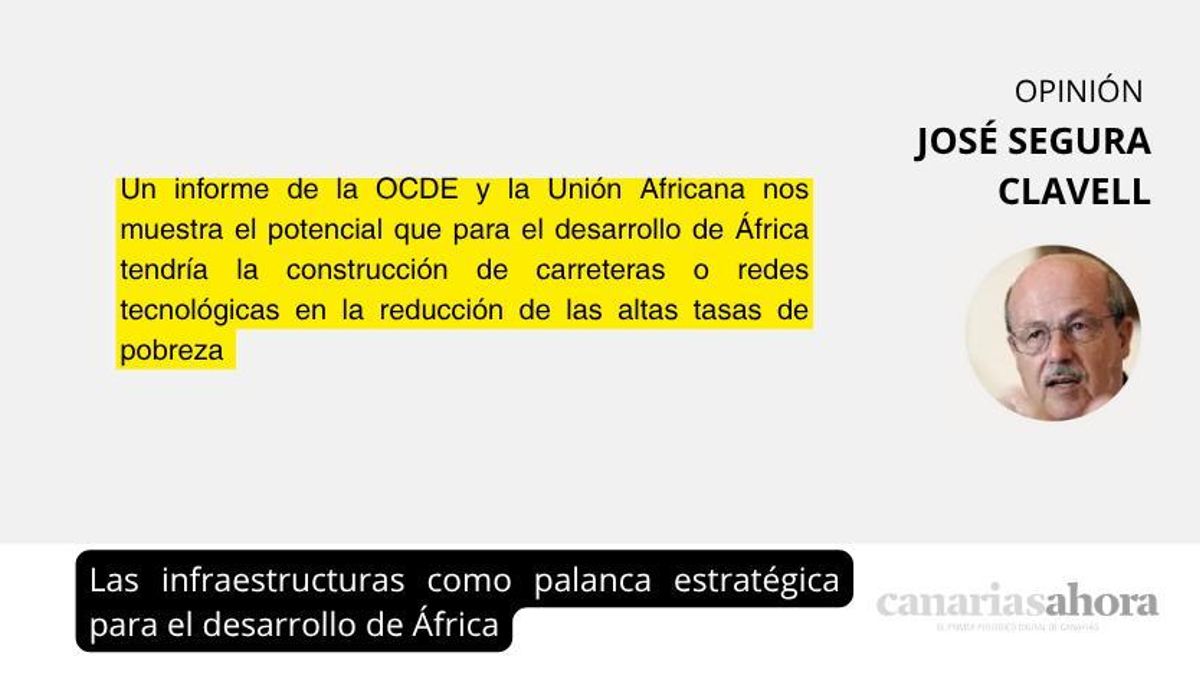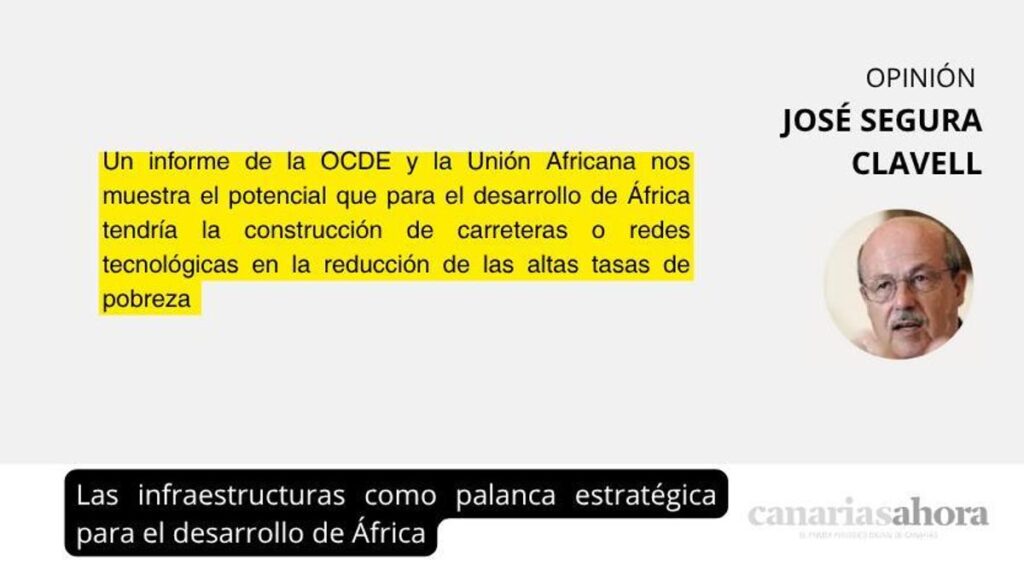Unlocking Africa’s Future Through Strategic Infrastructure
During a packed week at Casa África, we organized the presentation of a key international macroeconomic report on Africa in both Tenerife and Madrid. The report, known as African Development Dynamics, is published annually through a collaboration between the OECD Development Centre and the African Union Commission. Each year, it tackles a specific theme central to the continent’s economic development. This year’s edition focuses on a fascinating topic with significant potential for international collaboration: the impact of infrastructure development.
The Central Finding: Infrastructure as a Strategic Lever
The report reaches a fundamental conclusion: building infrastructure is not just a necessity for Africa; it is the key strategic lever for achieving the development targets set by the African Union in its master plan, Agenda 2063. The context is urgent. Despite Africa’s GDP multiplying by 4.2 times between 1990 and 2024, reaching $2.8 trillion, progress has now stalled. The COVID-19 crisis and increasing state fragility have created vast pockets of poverty.
The Stark Reality of Global Poverty
Today, nearly 700 million people worldwide live in extreme poverty, surviving on less than $2.15 per day. Africa, with a population of 1.3 billion, is home to 16% of the global population. The dramatic reality is that 67% of the planet’s population living in extreme poverty is in Africa. This means two out of every three people living in extreme poverty worldwide are African. Alarmingly, the numbers have worsened in recent years; poverty rates in low-income countries are now higher than they were before the pandemic.
A Century to Wait, or a Chance to Accelerate
As explained by Federico Bonaglia, Deputy Director of the OECD Development Centre, during the presentation, if faster and more inclusive growth is not achieved, the eradication of extreme poverty could take several decades. It could even take over a century for the African population to surpass the threshold of $6.85 per day. The 2025 African Development Dynamics report leaves no room for doubt: if Africa wants to reach the level of countries that have achieved exemplary productive transformation, it must mobilize an average annual investment of $155 billion until 2040.
The $155 Billion Benchmark
This figure is far from a mere technical data point. It represents 5.6% of Africa’s 2024 GDP and stands as the true thermometer of the continent’s ambition and commitment to its own future. Why is this threshold so relevant? Achieving this investment volume would not only close the infrastructure gap but would also have a multiplier effect on economic growth. The report’s calculations are compelling: with this capital injection, Africa’s GDP could grow by an additional 4.5 percentage points each year on average. This represents the real possibility of doubling the size of the African economy in just fifteen years and, more importantly, of surpassing the African Union’s ambitious 7% annual growth target set in Agenda 2063.
The Funding Gap and Structural Challenges
Despite the unquestionable need to invest in African infrastructure, the mobilization of resources remains insufficient. Between 2016 and 2020, the continent barely managed to gather $83 billion annually—just over half of what is truly required. The challenges are not temporary but deeply structural, manifesting on three main fronts.
First, there is sovereign debt and limited fiscal space. African governments have seen their room for maneuver drastically reduced. On average, they now spend seven times more resources on debt interest payments than on infrastructure investment. In 15 countries, spending on interest even exceeds that for new infrastructure.
Second, the high cost of private capital is a major barrier. Private sector participation is minimal, accounting for just 11% of total investment. The average cost of capital for infrastructure projects in Africa is 13%, significantly higher than the 8% seen in OECD countries. This highlights the urgent need to reduce perceived risk and improve transparency to attract investors.
Finally, uncertainty in development funding persists. Although bilateral and multilateral partners provide almost half of the investment, the future is uncertain. Official Development Assistance is projected to fall by up to 17% globally in 2025, a decline that will particularly affect the most vulnerable African countries, which already receive 40% less funding relative to their population.
The Gordian Knot: Where Will the Money Come From?
This ambitious plan inevitably leads to a simple yet critical question: where will the money come from? The great challenge remains access to financing, whether due to the heavy burden of external debt or the high interest rates that make any attempt at progress more expensive. The financial question is the true Gordian knot that Africa must untie if it wants to transform its potential into a tangible and lasting reality, and this demands a solidary effort from the rest of the world.
Priority Sectors and Regional Projects
The initiatives proposed in the report focus on infrastructure that accelerates productive transformation. It even suggests a breakdown for investment needs: road networks (32%), railways (24%), fibre-optic cables (23%), and the deployment of solar panels (17%). It is particularly interesting that the report identifies specific transport corridors that need development, citing 69 cross-border projects designed to boost regional trade and expand access to essential services.
For example, Federico Bonaglia explained that West Africa, our closest neighbour, needs to invest primarily in transport (more than half of investments) and in the digital sector, prioritizing all-weather roads and better access to energy to support agricultural transformation.
A Call to Action for Spanish and Canarian Business
The presentation in Tenerife’s Salón Noble del Cabildo was attended by the Director General for Relations with Africa of the Canarian Government, Luis Padilla, and the Director of External Action of the Cabildo, Pedro González, alongside a large group of provincial business leaders headed by Pedro Afonso of CEOE-Tenerife. In Madrid, several ambassadors, including those from Mali and Cape Verde, attended, as well as officials from the Ministry of Foreign Affairs, including the Director of Cooperation with Africa for AECID, Cecilia García.
In both locations, the presentation served to highlight the scale of Africa’s infrastructure needs and the efforts being made to mobilize funding. It was also, and should be, a wake-up call for the Spanish and Canarian business community. Our country is home to some of the world’s most recognized and experienced companies in executing bold and transformative infrastructure projects. However, faced with a continent demanding innovative solutions and unprecedented investment, one must ask: why is Spain, with all its potential and leadership in the sector, not more present in this African transformation process?
The opportunity is there, the need is evident, and international efforts to facilitate financing are advancing. Now is the time for Spanish companies to step forward and play a leading role in developing the infrastructure that will shape Africa’s future.


